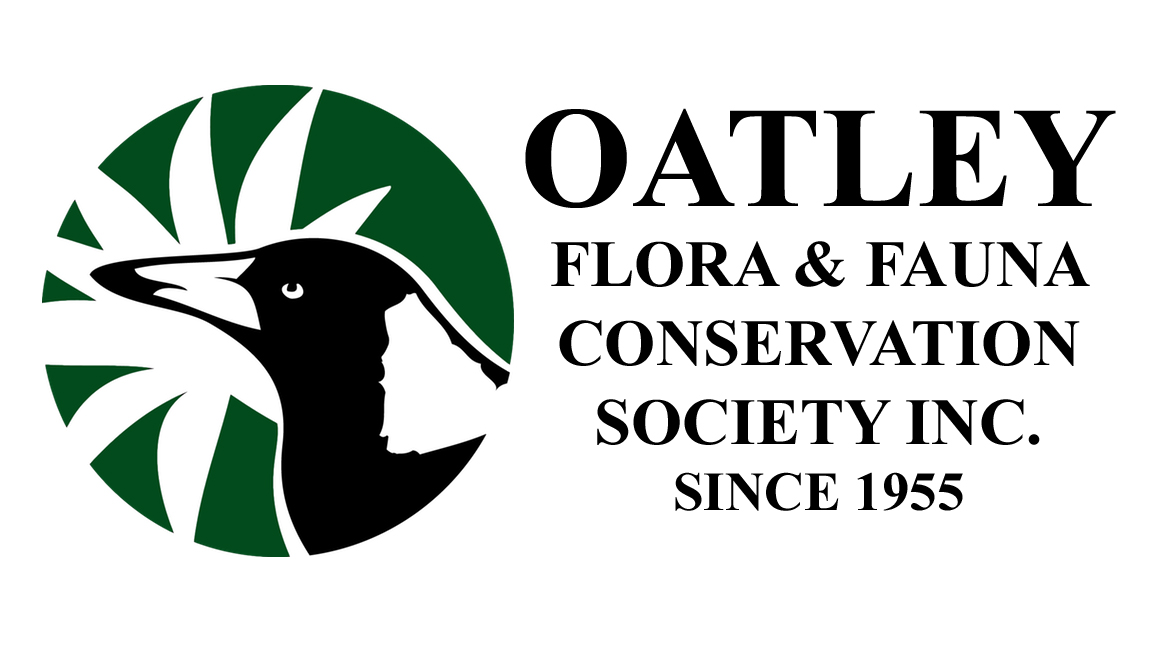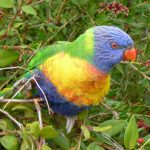
Rainbow Lorikeet – Trichoglossus haematodus, Bold, noisy fast-flying green missiles. Now the commonest parrot in Sydney. Laps nectar from flowers with a brush tongue. Nests in tree hollows and may displace less aggressive hole-nesting birds such as rosellas. 30 cm

Eastern Rosella –Platycercus eximius, Colourful parrot with a red head and white cheeks. Females and young are duller than the vivid males. Feeds mostly on the ground, eating seeds including thistles, buds, flowers and nectar. Chortles and wags its tail in a territorial display. 30 cm
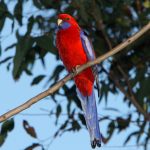
Crimson Rosella – Platycercus elegans, Large red and blue parrot with blue cheeks. Young birds are greenish. Prefers eucalypt forests and is common in the Blue Mountains. Feeds in trees and on the ground, on the seeds of eucalypts, grasses and shrubs. Clear piping calls. 34 cm
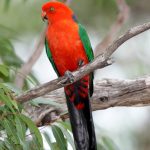
Australian King Parrot – Alisterus scapularis, Very large, long-tailed red and green parrot. While males are brilliant red and green with an orange beak, females and young birds are mostly green and have a grey beak. Feeds on fruit and seeds in trees and shrubs. Usually found in tall forests but becoming more common in Sydney suburbs. Long, high-pitched whistles. 42 cm
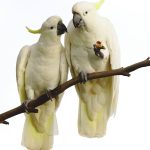
Sulpher-crested Cockatoo – Cacatua galerita, Very large white bird that raises a yellow crest to display. Congregates in raucous flocks and nests in large tree hollows. Eats seeds, nuts and roots and often feeds on the ground. Sometimes bites small branches off trees, littering the ground with leaves and blossom. 48 cm
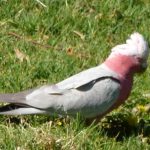
Galah – Eolophus roseicapillus, Small pink and grey cockatoo with a short crest. Flocks composed mostly of life-long pairs. Females have red eyes, males have brown eyes. Waddles over the ground, tearing up tubers and eating seeds. Very common in inland Australia, numbers increasing in Sydney. Call is a shrill screech. 35 c
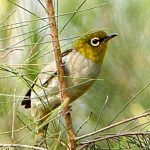
Silvereye –Zosterops lateralis, Small plump greenish bird that moves about in flocks. Feeds in shrubs and trees, eating small berries and insects. Silvereyes from Tasmania migrate north to Sydney in winter and mix with local birds. Dark reddish-brown sides and pale throats distinguish the migrants from residents which have pale sides and yellow throats. 11 cm
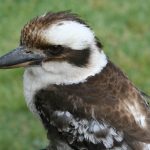
Laughing-Kookaburra – Dacelo novaeguineae, Very large woodland kingfisher with sharp eyesight. Sits on branches looking intently at the ground, then dives down to snatch insects and small reptiles in leaf litter. Family groups call in cackling, chuckling choruses. Beware! Some kookaburras snatch food from barbeques. 42 cm
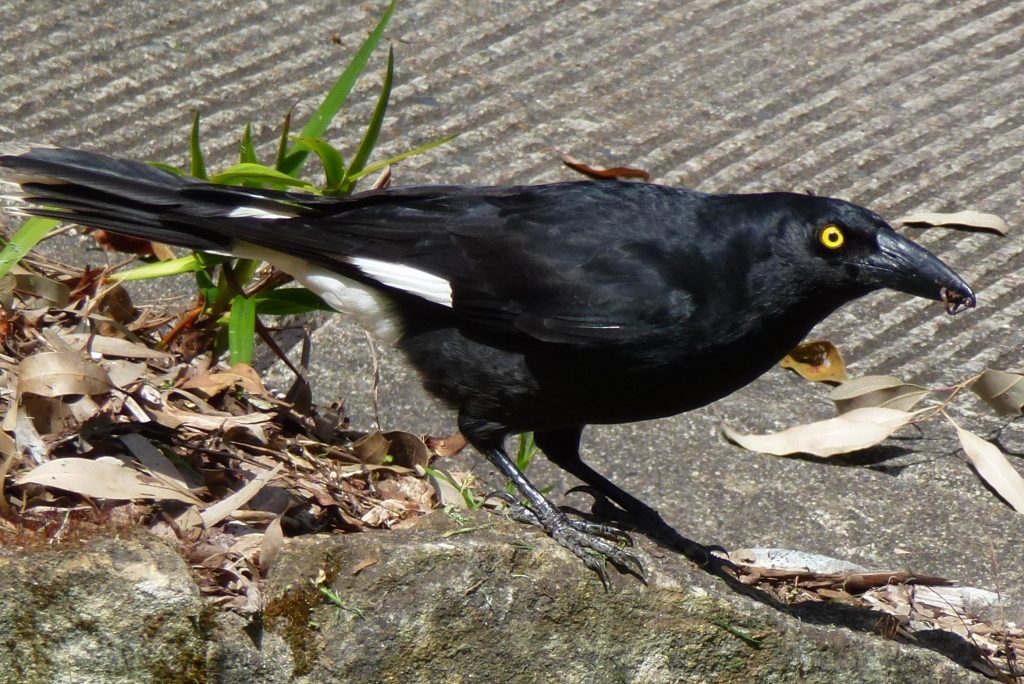
Pied Currawong – Strepera graculina, Large black bird with yellow eyes, a thick black beak and white patches on wings and tail. Eats fruit and insects and also steals food from picnickers. Sometimes fooled into raising the young of Channel-billed Cuckoos which lay their eggs in the currawong’s nest. Loud echoing calls. 48 cm
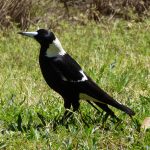
Australian Magpie – Cracticus tibicen, A large black and white bird with dark brown eyes. Males have pure white napes, females have greyish-white napes and young birds are grey instead of black. Walks along peering and listening then digs for insects and seeds. Musical carolling calls. Males defend their territories in Spring and Beware! a few may attack people near their nests. 40 cm
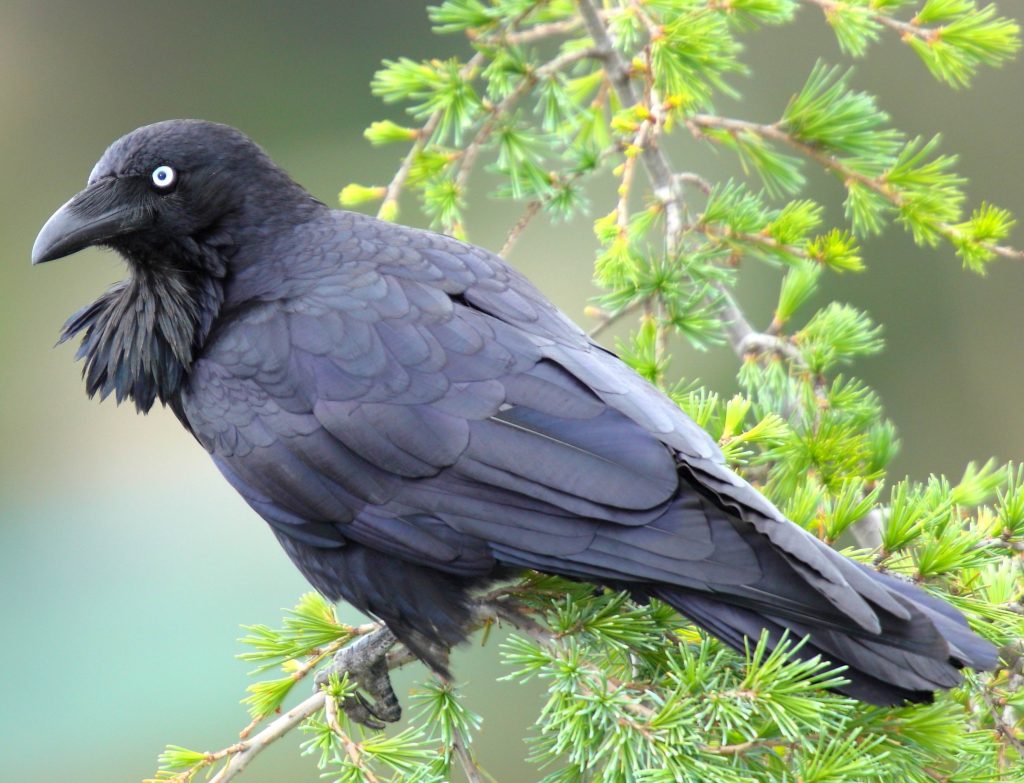
Australian Raven – Corvus coronoides, Very large, all-black bird with a heavy black beak and white eyes. Young birds have dark eyes. In urban areas small flocks fly high, searching for food scraps; also eat insects and seeds and raid nests for eggs and nestling birds. On the ground, ravens progress in hops. Call is a loud slow ‘aark, aark, aaaaark”. 52 cm
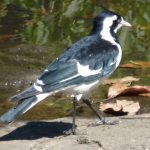
Magpie-lark (Peewee) – Grallina cyanoleuca, Medium-sized, slim black and white bird with pale eyes and bill. Usually seen in pairs walking briskly about short grass and roadsides, pecking at insects. Pairs display side by side on a perch, opening and closing their wings with a duet of shrill clinking notes. Builds a nest out of mud, on a horizontal branch. 28 cm
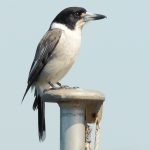
Grey Butcherbird – Cracticus torquatus, Medium-sized, grey and white bird with a black head and a long hooked beak. Young birds are greyish-brown and may be mistaken for kingfishers. Eats insects and small reptiles and birds. It sometimes wedges uneaten prey in branches, so earning its common name. Piping song and harsh scolding calls. 27 cm
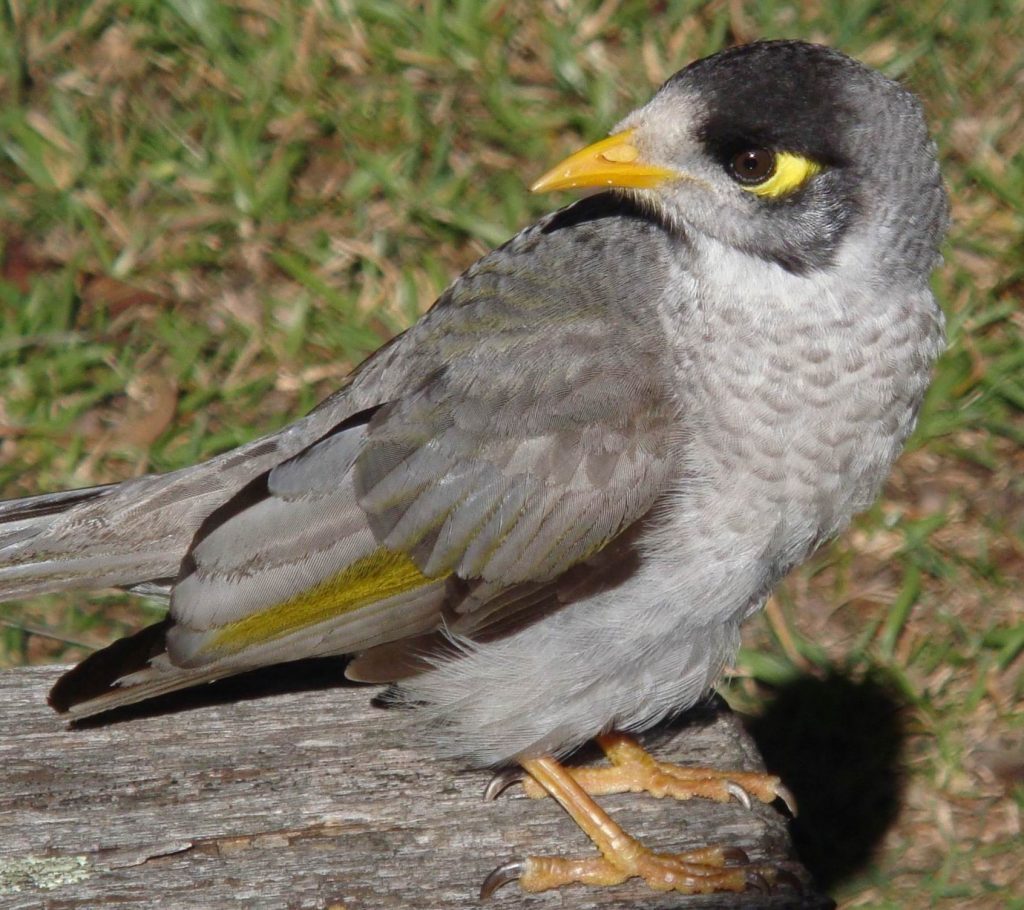
Noisy Miner – Manorina melanocephala, Native honeyeater that lives in noisy aggressive flocks and drives other birds out of its territory. Has a yellow bill, legs and eye patch like the introduced Common Myna, but it is grey, not brown. Prefers habitat with large trees, open ground and nectar-rich flowering shrubs. Builds cup-shaped nest of fine twigs, in a shrub. 26 cm
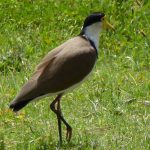
Masked Lapwing – Vanellus miles, Long-legged brown and white bird with black cap and flap of yellow facial skin. Usually seen in pairs stalking about playing fields and open ground. Loud clanking call, sometimes heard at night. Nest is a shallow hollow on the ground and the eggs and chicks are camouflaged by a mottled pattern. Beware! Pairs may dive-bomb people close to their nest. 36 cm

Tawny Frogmouth – Podargus strigoides, Night bird with pale streaked and blotched plumage that perches during the day in a tree with eyes closed, looking just like a dead branch. Very difficult to see even when it is sitting on its flat stick nest in a tree fork. Unlike an owl, it has a very broad beak and weak feet. Feeds at night, grabbing insects, snails and worms in its beak. Call is a long low pulsed hoot. 44 cm
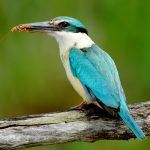
Sacred Kingfisher – Todiramphus sanctus, Medium-sized blue-green kingfisher with whitish belly and neck. Like the kookaburras, it perches on a branch scanning the ground for insects, other invertebrates and small reptiles, then dives down to snatch its prey and returns to the perch to eat it. Migrates south to Sydney in Summer and nests in a hollow, often excavated in a termite nest. Loud continuous call of ‘kek, kek, kek”. 21 cm
